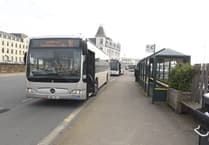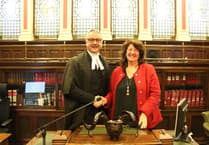We live on a beautiful island and one of my favourite things is walking around our countryside, towns and villages.
I think one of the attractions not only for ourselves, fortunate to live here, but for those people we welcome to the island during normal times is the variation of natural beauty, culture and heritage.
We have beaches on the northwestern coast that go on for miles, 18 national glens, a range of public footpaths and hills from which to admire the views, quaint and distinct villages and towns where the local stone dominates - such as Peel with sandstone and Castletown with limestone - and traditional Manx cottages and farms which still have sod hedge or dry stone boundaries in criss-cross pattern.
Then there are the timeless seaside ports and beaches where children have played for generations.
Several government departments, local authorities, Manx National Heritage, Manx Utilities, individuals and groups all have a role to play in relation to these priceless assets.
From a tourism perspective the promotion of adventure activities, cycling, walking and other outdoor pursuits with a range of organisations to suit the needs of interested parties are listed under the website www.visitisleofman.com and we obviously look forward to welcoming friends back to share our treasures.
The Isle of Man is ideally placed for these activities as long as we all pull together to provide what our potential customers require.
There is also the Manx Footpath Conservation Group, which was established in 1971 originally lobbying for the implementation of public rights of way legislation, which regularly monitors the footpath provision and reports issues such as broken gates, damage and missing signage for example.
It has a valuable role organising walks on footpaths, hills and moorland around our island alongside other groups.
We should be proud of our 272km of public rights of way on our island, the Millennium Way, a permanent 26-mile reminder of the 1979 Millennium of Tynwald; the Bayr ny Skeddan, 14 miles between Castletown and Peel; the Raad Ny Foillan, the 96-mile coastal footpath, which unfortunately still diverts in places away from the coast and should be completed as the name suggests; the Heritage Trail, a 26-mile route over former railway lines, lost in the 1960s, between Douglas and Peel, St John’s to Sulby and to Foxdale.
There are now ambitious plans to put in place further such footpaths in various places, which must be welcomed.
I think the work undertaken by the Department of Environment Food and Agriculture in recent years has been very much more proactive in relation to the glens, forests, amenity land and uplands being available for public enjoyment, exercise and leisure use.
The forestry, amenity and lands division has an annual budget of £1.7m to cover administration, management and maintenance of these features, equipment, staff training, contractors, timber harvesting as well as operating the Tree Preservation Act. This year in the capital project budget £300,000 was allocated for the glens.
Works are currently in progress at Port Soderick, consisting of access and car park improvements, Dhoon Glen, where footpath and bridge works are being undertaken and at the people’s wood at Meary Veg planting is under way.
Works planned for 2021 include footpath, bridge and access improvements at Groudle Glen and Glen Maye.
Other projects include an extension to the car park and drainage improvements at the Millennium Oak Wood; a new playground and car park improvements at Laxey Glen; a car park extension in addition to works to improve the mountain bike trail at Archallagan and repairs to the traditional roundabout are underway at Silverdale with further works to follow.
I think the cooperation with private business operators at Archallagan has proved very successful in terms of leisure pursuits in the countryside and the division has also worked with Zurich to make improvements there and with the Isle of Man Bank at Ballaugh.
I understand discussions are under way with a third sector organisation regarding the management of waste bins throughout the DEFA estate, which is also good news. Other such organisations working with the department include Manx Wildlife Trust and the Dalby community project.
From a Department of Infrastructure perspective, budgets are available for public footpath maintenance of £359,496, roadside ditches in the countryside £158,544 and river maintenance of £203,064. Drainage gullies in towns are funded and operated by local authorities which raises the question whether it is right that government is responsible out of town for such work but it falls on town ratepayers?
The department works with Beach Buddies on public footpath maintenance, which in the past was always at the tail end of the funding. The Isle of Man Four-Wheel Drive Club, part of the Green Lane Users’ Group, undertakes supplementary work to assist maintenance.
Also the department ’rests’ green lanes to allow them to improve after damage has been caused often by water flows or irresponsible users.
When I was Minister for Infrastructure, with support from the prison I attempted to provide work on the footpaths, under supervision, for trusted prisoners but unfortunately it did not progress.
During the first part of this year it seemed to me that the public footpaths I was using were more muddy and slippery in places and, having checked with the Ronaldsway Met Office charts, it is clear that we have had more rain in the last two quarters than 2015/16, which was exceptional in recent years.
Further and I think quite telling is the fact that since January we have had 132mm over 46 days that had rain and in 2016 it was 113mm over 64 days when we had rain.
Many have been forecasting this trend of heavier rain.
So it is reasonable to assume this may develop into a consistent pattern and we need to make preparations?
I think it is useful to see whether everything that has been done in a certain way for a period of time may be carried out more effectively.
Also, whether decisions taken with the benefit of hindsight might be worthy of reconsideration.
We have ongoing issues with maintenance and drainage of some land and ditches in the countryside. Water can find itself settling under tarmac and if it freezes can lift the surface.
We have witnessed detritus in our rivers getting blocked, silting up and causing flooding issues, particularly in a valley below developments where harder surfaces speed up water discharge. Do we have the best system of maintenance of gullies?
Again with blocked leaves, silt and other substances blocking them unless regularly cleared as soon as the heavy rain comes then flooding follows.
Was it the right decision (and I don’t even remember why and when it happened) to do away with the specialist rivers and bridges gang on the Highway Board?
Were we better served with local maintenance gangs who knew through experience where the problem areas were?
Clearly we have to protect the environment but that must be able to be achieved with sensitivity.
Just as most sod hedges with wildflowers are better with less heavy maintenance to protect wildlife surely an environmental balance can be struck to ensure rivers and streams do not silt up and cause blockages without causing harm to those species whose habitat this is.
We need to work with landowners and lead by example on upland areas to put in place so called soft measures to slow down run off. I have witnessed work on the lower part of South Barrule to slow this down by the use of sphagnum dominated vegetation.
Do we really need several departments looking after these important features?
Would it not be appropriate for one government agency to care for all our amenity land, forests, glens, uplands in public ownership, rivers and drainage systems because in nature each depends on the other.
Clearly we do at present have different expertise in different departments and boards.
Manx National Heritage obviously has a clear priority as its name suggests. Manx Utilities looks after footpaths around reservoirs and amenity land but it really isn’t its top priority, DEFA, with its responsibilities for glens, forestry land, upland and amenity land and Department of Infrastructure, with responsibilities for public footpaths green lanes and so on, could usefully be amalgamated.
They could then coordinate activities and the ongoing maintenance of rivers, drainage ditches and so on combined with action to slow down flow in the uplands could be better placed to take on increased challenges in this area in the years ahead for the benefit of residents and those who come to enjoy our special place?
It has to be worth investigation from a number of different perspectives.




